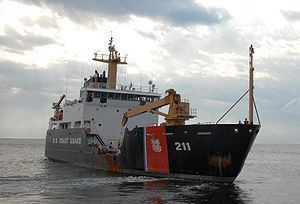Name USCGC Oak (WLB-211) Laid down 30 July 2001 Status in active service Launched 26 January 2002 Builder Marinette Marine | Namesake Oak tree Commissioned 7 March 2003 Construction started 30 July 2001 Length 69 m | |
 | ||
Class and type Juniper-class seagoing buoy tender | ||
The USCGC Oak (WLB-211) is a United States Coast Guard seagoing buoy tender, the second of her name and the eleventh of the Juniper-class. Home-ported in Newport, Rhode Island the ship tends buoys along the Northeastern U.S. coast. The Oak also performs other duties, such as maritime border security, marine environmental protection, maritime law enforcement, search and rescue, and domestic icebreaking. She is also responsible for maintenance support of the National Oceanic and Atmospheric Administration (NOAA) National Data Buoy Center's offshore weather buoys.
Contents
Construction and characteristics
USCGC Oak was built by the Marinette Marine Corporation in Wisconsin, launched on 26 January 2002 and commissioned in March 2003. She has a length of 225 ft (69 m), a beam of 46 ft (14 m), and a draft of 13 ft (4.0 m). Oak is propelled by two Caterpillar diesel engines rated at 3,100 horsepower, and has a top speed of 16 knots. She has a single controllable-pitch propeller, which along with bow and stern thrusters, allow the ship to be maneuvered to set buoys close offshore and in restricted waters. A dynamic global positioning system coupled with machinery plant controls and a chart display and information system allow station-keeping of the ship with an accuracy of within five meters of the planned position without human intervention. Oak is also equipped with an oil-skimming system known as the Spilled Oil Recovery System (SORS), which is used in her mission of maritime environmental protection. The cutter has a 2,875 square foot buoy deck area with a crane that is used for servicing large ocean buoys.
Mission
USCGC Oak has an area of responsibility within the First Coast Guard District which covers the northeast United States, up to the Canadian border. While her primary mission is servicing aids-to-navigation (ATON), she is also tasked with maritime law enforcement, marine pollution prevention and response, treaty enforcement, defense and homeland security, and search and rescue. In addition her primary mission of servicing ATON, Oak is also tasked with the placement, service, and coverage of NOAA weather buoys off the northeastern coast of the United States. Oak has an icebreaking capability of 14 in (0.36 m) at 3 knots and 3 ft (0.91 m) backing and ramming.
History
The keel for the Oak was laid on 30 July 2001 at Marinette Marine Corporation in Marinette, Wisconsin. Oak was launched on 26 January 2002. The ship's sponsor was Mrs. Billye Brown, wife of Congressman Henry E. Brown (R-SC). Oak made the trip from Marinette to Charleston, SC and was commissioned on 7 March 2003, the first Coast Guard cutter to be commissioned following the creation of the Department of Homeland Security.
In January 2008, Oak rescued a disabled sailing vessel off the coast of St. Croix, U.S. Virgin Islands. During the 2009 presidential inauguration of Barack Obama, Oak was designated as the lead waterside security asset utilizing the crew's law enforcement training, the cutter's communications suite and her icebreaking capabilities on the Potomac River. Oak was involved in Operation Unified Response following the 2010 Haiti earthquake, primarily to clear debris from and repair Port international de Port-au-Prince, the damaged seaport in Port-au-Prince. She was dispatched immediately following the quake, stopping in Miami, Florida on the way to stock with relief supplies. The vessel arrived on 17 January 2010, about six days after the disaster struck. She and the Navy salvage ship USNS Grasp were tasked with returning the wharves to operation. Oak left Naval Air Station Pensacola on 4 May 2010 loaded with oil spill recovery equipment bound for the Deepwater Horizon oil spill in the Gulf of Mexico where she assisted in clean-up efforts. In July and August 2011 Oak successfully used her side-scanning sonar to locate a self-propelled, semi-submersible vessel (SPSS) that had been sunk during a drug interdiction conducted by USCGC Seneca. A Federal Bureau of Investigation dive team aboard Oak retrieved the cocaine cargo of the SPSS and Oak crew members loaded seven metric tons worth approximately US$ 180 million onto her buoy deck. Oak has assisted in clearing waterways and repaired ATON impacted by hurricanes Isabel, Katrina, Charley, Jeanne, and Frances.
